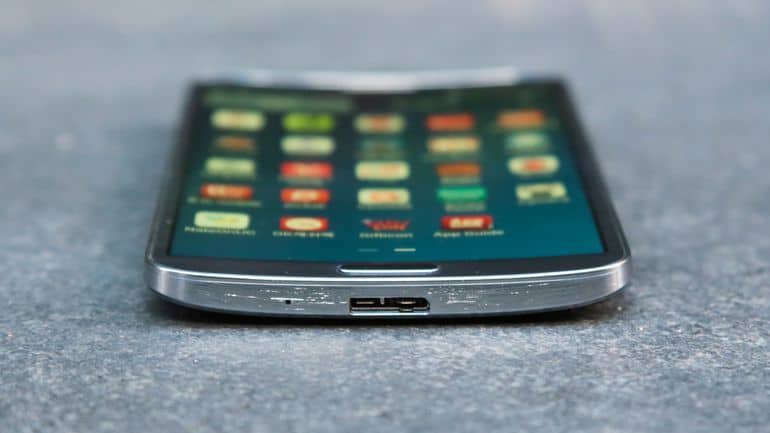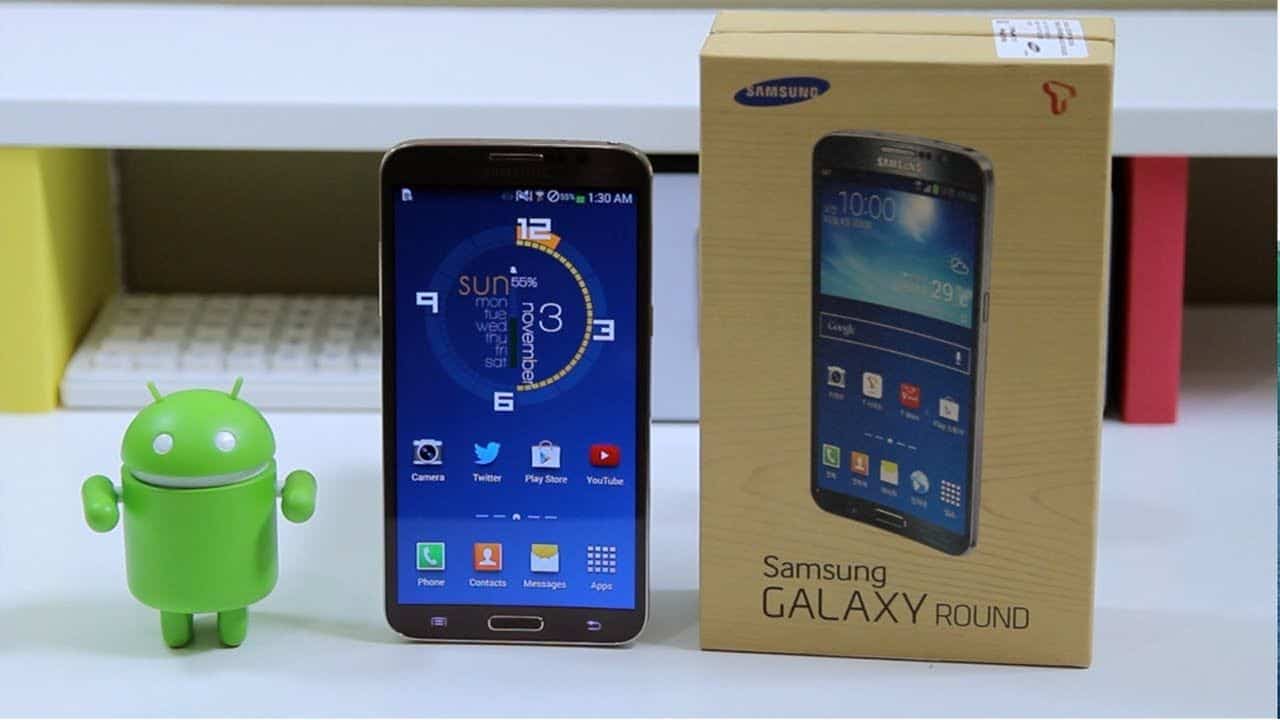Table of Contents
amazon Samsung Galaxy Round reviews
Design
In appearance, Samsung Galaxy Round is almost 1 version no stylus as Samsung Galaxy Note 3. Along the dorsal ownership pattern plastic skin, 5.7 inch screen, USB 3.0, it is difficult to distinguish when the Samsung Galaxy Round only seen from a distance. Besides, it is difficult for the user to feel the curvature of the machine, especially when only looking at the back. However when holding the product on hand immediately apparent difference.
Firstly, the weight, the Samsung Galaxy Round slightly lighter than Note 3, this difference is not clear due to the machine missing stylus or the battery level of the Round lower than Note 3 (2800mAh vs 3200mAh).
Furthermore, despite the same size screen 5.7 inches, the Samsung Galaxy Round for feeling comfortable grip than Note 3. We can say with screen size more 5 inches, you will hardly find product bring feeling better grip as Galaxy Round.
where can you get a Samsung Galaxy Round online
Samsung Galaxy Round SM-G910S Real Round Curved Display smart phone Factory unlocked: Buy it now
Screen
Perhaps this is the main point of interest to users Galaxy Round, It is one of the pioneering equipment for curved display technology, the Galaxy Round is expected to be a decisive factor viability, development ideas on the curved screen smartphone.
As for the visual effect must be acknowledged that in addition to the screen feels a bit strange to look for the screen surround effects of the Galaxy Round hardly brought little improvement in image and visibility except resistance to glare in the sun seems to be slightly better than the Note 3 by the curved screen inside. Can see the screen of the Galaxy Round is also used in conjunction with Note 3, synonymous with color, brightness and great detail. The curved screen horizontally not affect the use of machines such Lanscape mode when watching movies, browsing the web because their actual shape curvature is not too much.
Display Quality
Super AMOLED Brilliance
The Samsung Galaxy Round’s display was one of its standout features, not just because of its curved design, but also due to the quality of the Super AMOLED panel. With a resolution of 1080 x 1920 pixels and a pixel density of approximately 386 ppi, the display was sharp and clear. The Super AMOLED technology ensured deep blacks, vibrant colors, and excellent contrast ratios, making the display a pleasure to look at.
The 5.7-inch screen size was ideal for media consumption, whether it was watching videos, playing games, or browsing the web. The curved nature of the screen was intended to enhance the viewing experience, creating a more immersive feel. However, the curvature was subtle, and while it did slightly reduce glare from ambient light, the difference was not dramatic enough to revolutionize the way users interacted with their phones.
Viewing Angles and Brightness
One of the advantages of Super AMOLED technology is the wide viewing angles, and the Galaxy Round did not disappoint in this regard. Colors remained consistent and vivid even when viewed from extreme angles, which was particularly useful for sharing content with others. The display was also bright enough to be used comfortably outdoors, although it could struggle under direct sunlight, a common issue with AMOLED screens.
Impact of the Curved Screen on Usability
The curved screen had a mixed impact on usability. On the one hand, it added a unique aesthetic that made the Galaxy Round stand out in a crowded market. On the other hand, it raised concerns about durability, especially in terms of how the screen would hold up if the phone were dropped. The curvature also made it challenging to find suitable screen protectors and cases, as most accessories were designed for flat screens.
Despite these challenges, the Galaxy Round’s display was generally well-received. It showcased Samsung’s willingness to experiment with new ideas, even if the execution was not perfect. The curved screen was more of a conversation starter than a game-changer, but it paved the way for future innovations in smartphone design.
Performance
Hardware Specifications
Under the hood, the Samsung Galaxy Round was powered by a Qualcomm Snapdragon 800 chipset, one of the most powerful processors available at the time. It featured a quad-core Krait 400 CPU clocked at 2.3 GHz and an Adreno 330 GPU, ensuring smooth performance across various tasks. The phone also came with 3 GB of RAM, which was more than sufficient for multitasking and running demanding applications.
The Galaxy Round was equipped with 32 GB of internal storage, with the option to expand it via a microSD card slot, supporting cards up to 64 GB. This combination of powerful hardware and ample storage made the Galaxy Round a capable device for its time, able to handle everything from basic tasks to more intensive applications like gaming and video editing.
Real-World Performance
In everyday use, the Samsung Galaxy Round performed admirably. The Snapdragon 800 chipset provided snappy performance, with apps launching quickly and minimal lag during multitasking. The 3 GB of RAM ensured that the phone could keep multiple apps running in the background without slowing down.
Gaming on the Galaxy Round was a smooth experience, thanks to the Adreno 330 GPU. Popular games like “Asphalt 8: Airborne” and “Real Racing 3” ran without issues, with high frame rates and no noticeable stuttering. The curved screen added a unique visual element to gaming, although it did not significantly impact gameplay.
In terms of benchmarks, the Galaxy Round scored well across the board. In AnTuTu, it consistently achieved scores above 30,000, placing it among the top performers of its time. In Geekbench, the phone scored around 950 in single-core tests and 2,900 in multi-core tests, reflecting its strong performance capabilities.
Software and User Interface
The Samsung Galaxy Round ran on Android 4.3 Jelly Bean out of the box, with Samsung’s TouchWiz UI layered on top. TouchWiz was known for its feature-rich experience, offering a wide range of customization options and additional features not found in stock Android. However, it was also criticized for being bloated and occasionally causing performance slowdowns.
One of the unique features introduced with the Galaxy Round was the “Roll Effect,” which took advantage of the curved screen. By tilting the phone, users could see notifications, battery status, and other information without fully waking the device. This feature was a clever use of the curved design, although it was more of a novelty than a must-have functionality.
The Galaxy Round also included other Samsung-specific features, such as Multi-Window, which allowed users to run two apps side by side, and Smart Stay, which kept the screen on as long as the user was looking at it. These features added value to the user experience, but they also contributed to the overall heaviness of the TouchWiz UI.
Samsung’s decision to pre-load the Galaxy Round with numerous apps and features led to mixed reactions. While some users appreciated the added functionality, others found the software to be overly complicated and cluttered. Fortunately, many of the pre-installed apps could be disabled, and Samsung provided regular software updates to improve performance and stability.
Battery Life
The Samsung Galaxy Round was equipped with a 2,800 mAh removable battery, which was relatively standard for a smartphone of its size and specifications. In real-world use, the battery life was decent but not exceptional. With moderate use, including web browsing, social media, and some gaming, the phone could last through a full day on a single charge.
However, heavy users who engaged in extended gaming sessions or video streaming might find themselves reaching for the charger before the day was over. The curved screen, while visually appealing, did not significantly impact battery life, as it was still an AMOLED display, known for its power efficiency when displaying dark content.
The Galaxy Round supported fast charging, a feature that was becoming increasingly common in smartphones at the time. This allowed users to quickly top up the battery, which was a welcome addition given the average battery life. The removable battery also meant that users could carry a spare battery for extended use, a feature that has since become less common in modern smartphones.
Connectivity and Network Performance
The Samsung Galaxy Round was a fully equipped smartphone in terms of connectivity. It supported 4G LTE, which was still a relatively new technology in 2013, providing fast data speeds for web browsing and streaming. The phone also included Wi-Fi 802.11 a/b/g/n/ac, Bluetooth 4.0, NFC, and an IR blaster, which allowed it to function as a remote control for various home electronics.
Call quality on the Galaxy Round was generally good, with clear audio and strong signal reception. The phone’s curved design did not interfere with its antenna performance, and users reported consistent connectivity even in areas with weaker signals. The inclusion of a 3.5mm headphone jack was also a plus, as it allowed users to use their existing headphones without the need for an adapter.
The Galaxy Round’s GPS performance was solid, with quick and accurate location fixes. This made it a reliable device for navigation, whether using Google Maps or other GPS-based apps. The phone also supported GLONASS, which improved location accuracy in certain regions.
Conclude
Flexible display technology is still in the stage of pregnancy, the Samsung Galaxy Round is just the start of a step in a very long marathon to explore the new equipment segment. So do not rush to judge the success or failure of the product line or one idea over version “draft” as the Galaxy Round.

